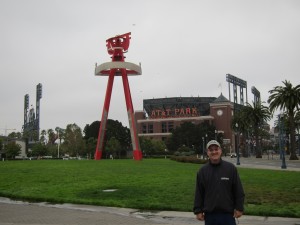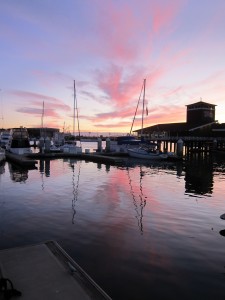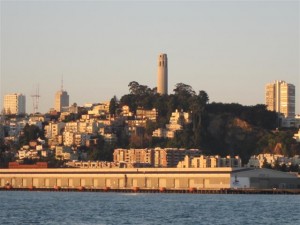When we initially arrived in the Bay Area, we stayed in South Beach Harbor marina, next to the AT&T ballpark in the heart of San Francisco.
As much as we loved being in the city, we didn’t enjoy the slip we were in at the marina. There was no Internet, it was a long walk to shore and it was so rolly we felt like we were at sea, particularly in the afternoons when the wind picked up. Christi would find any and every excuse to get off the boat, so she didn’t get much work done on the books.
After a month, we moved across the bay to Jack London Square in Oakland.
We enjoyed our time in Oakland. Not only was the marina good, we were in a great location. We had easy access to the ferry and the subway, making it quick and easy to get to San Francisco. We could walk to all kinds of amenities. And it was a gentrification area with a lot of character and charm. We also were in Oakland when the first round of riots occurred, and it was interesting to be in the middle of the action. Once Eric had to walk past a police barricade on his way home from work.
We left Oakland on October 28th at 0700. The sun didn’t rise until 0730, so we got ready in the dark and untied just as light was starting to break on the horizon. It was an exceptionally clear and calm day in the bay, with smooth seas and no fog. The windows of the buildings in the city reflected the fiery red sunrise. We had a current pushing us through the bay at easily did 7 knots.
When we neared the Golden Gate Bridge, we were surprised to see it wasn’t enshrouded in fog in the morning, which is rare. The fog is so thick and persistent that most of the time it is impossible to see the mouth from the ocean — it took European explorers nearly 200 years of exploring the coast of California before they discovered the bay! The mouth of the bay was named the Golden Gate. The bridge passes over the top of the mouth.
As we started to pass under the bridge, the water got rough and our speed instantly dropped a knot. The water looked like it did in Manihi’s pass, like boiling water dotted with several whirlpools and overfalls. The auto pilot went a little nutty in the inconsistent waters. The roughness was caused in part by two currents colliding. By the time we had cleared the bridge, we were solidly in the waters of the outer bay. It was a rougher ride than we’d hoped for and we both turned a little green.
Out in the open ocean, we experienced 4 foot swells coming from the starboard aft corner. Really, not bad conditions at all, so we were both surprised that we were still green—probably a result of the corkscrew motion the boat makes in these kinds of waves. Eric took some drugs and felt a bit better. Christi, couldn’t take anything since she was pregnant, which was unfortunate. The corkscrew motion is the hardest for her to take.
As the day progressed, the conditions slowly worsened. By late afternoon, the wind was over 20 knots with the swells growing to six feet from the northwest. The wind more or less died during the night, but the conditions didn’t get any better. We had a small crescent moon that set early and we were in an area without many lights from shore, so the stars were vibrant.
As soon as the sun rose and the wind picked up, the conditions again slowly but steadily worsened. The seas becoming confused, with lots of breaking whitecaps. Christi was green all day.
We each think we may have spotted whales on our watches, but weren’t sure. Christi saw something large pop up on the radar alarm nearby, then disappear. She looked at the spot and thought she saw several whale spouts, but admits they could have just been white caps. She watched for a long time and didn’t see any whales. While Eric was on watch, he thought he saw a whale jump up out of the corner of his eye, but when he looked, there was nothing there. He also watched for a while and didn’t see anything else.
By late afternoon, the seas were seriously confused, with 8 foot swells coming from multiple directions. We experienced some some fifteen degree rolls here and there. The active fin stabilizers were working hard, but even so, it was uncomfortable to walk around and Eric became green again, despite the drugs. We were concerned about how much worse it would get when we got to Point Conception.
Shortly after the sunset at 1815. The wind died shortly thereafter, but just like the night before, the conditions did not improve. The moonset at 2045, and we were mesmerized by the fact that it was red. We’ve only seen red moonsets a handful of times.
We made it to Point Conception shortly before 2200, and surprisingly, the seas were no worse than they had been. In fact, they may have been a touch better. We had a favorable current with us and cleared the point in about two hours.
After clearing the point, the sea conditions improved steadily, eventually becoming calm with swells at only three feet and wind waves at about a foot. Winds stayed light and the conditions remained the same for most of the afternoon. Even though the seas were nice, Christi never felt better.
Shortly after sunset, though, the wind picked up on the nose and we started to get some head seas. That didn’t last long, though. The wind died at 2300 and a thick fog rolled in, calming the seas.
At the still pitch black of 0600 am, as we were nearing San Diego Bay, we had a near collision. A boat doing about 10 knots popped up on radar that was approaching us from our port forward side. Per the regulations it was supposed to change course, but it did not. We know he could not see us, since the running lights were useless in this fog. We had to assume the didn’t have radar or was not paying attention to it. We had our fog horn blaring, but they probably couldn’t hear it over the roar of their engines. To our port side was lots of kelp. We tried to make some smaller adjustments to avoid a collision, but the other vessel seemed somewhat erratic. It started to get really close. Eric decided to avoid the kelp and just pull a u-turn to open up some distance between us and their vessel. This did the trick, but the other boat till got awfully close. We don’t think they ever even knew we were there. We just barely saw his running lights in the dense fog at our closest point of approach, probably less then 300 feet away.
Oddly enough, after rounded the corner of Point Loma into the entrance of San Diego Bay, the fog vanished. The sky was just beginning to lighten in the pre-dawn, so within five minutes we went from black and zero visibility to clear and good visibility.
Christi had hoped to finish writing the Recipe for Success: What My Cruising Will Cost Me workbook on the passage, as well as writing some blog posts about our time in the Bay Area. However, since she wasn’t feeling good, she didn’t get any writing done.
This is part 11 of an 11 part series on our time in the San Francisco Bay area. Read part 10 here.




